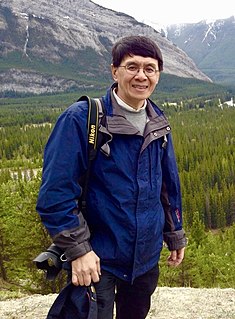
Sham Shui Po is an area of Kowloon,Hong Kong,situated in the northwestern part of the Kowloon Peninsula,north of Tai Kok Tsui,east of Cheung Sha Wan and south of Shek Kip Mei (石硤尾). It is located in and is the namesake of the Sham Shui Po District.

Hei Ling Chau,formerly Hayling Chau,is an island of Hong Kong,located east of Silver Mine Bay and Chi Ma Wan of Lantau Island. Administratively,it is part of the Islands District.

Sha Tin,also spelt Shatin,is a neighbourhood along Shing Mun River in the eastern New Territories,Hong Kong. Administratively,it is part of the Sha Tin District. Sha Tin is one of the neighbourhoods of the Sha Tin New Town project.
This is a list of prisons in Hong Kong managed by the Correctional Services Department.

Lai Chi Kok is a neighbourhood in Kowloon,Hong Kong,east of Kwai Chung and west of Cheung Sha Wan. Mei Foo Sun Chuen is the largest housing estate in the area and also the largest in Hong Kong with 99 blocks. Administratively,it belongs to Sham Shui Po District.

Princess Margaret Hospital or PMH is a major acute district general hospital in south Kwai Chung,New Territories,near Lai Chi Kok,Kowloon,Hong Kong,managed by the Hospital Authority. It provides services for patients from Lai Chi Kok,Lower Kwai Chung,Tsing Yi,Tsuen Wan,and Tung Chung Districts.

Tai Po New Town,or Tai Po Town,is a new town and non-administrative area in Tai Po District,in the New Territories,Hong Kong. The area is a planned town that surrounding the existing indigenous market towns Tai Po Hui and Tai Po Kau Hui,as well as east of the existing indigenous villages that located on the Lam Tsuen Valley as well as west of those villages in Ting Kok and Tai Mei Tuk and south of those villages in Nam Hang,Fung Yuen and Sha Lo Tung. Most of the lands of the new town were obtained by land reclamation. In present day,Tai Po New Town was simply known as Tai Po. The new town are largely covered by the government Tai Po Outline Zoning Plan,which legally regulated the land use of the area,on top of the terms in the land lease contract with the government. Some of the land lease within the area,were known as Tai Po Town Lot №foo. In election,the town had a different zoning scheme for the election constituencies.

Sham Shui Po Park is a park in Sham Shui Po,New Kowloon,Hong Kong. It comprises two physically discontiguous sites on either side of Lai Chi Kok Road. The larger site is more well-known as Sham Shui Po Park. The smaller,located within Lai Kok Estate and originally managed by the Housing Authority,became part of Sham Shui Po Park when it was transferred to the Leisure and Cultural Services Department.

Lui Seng Chun is a Grade I Historic Building located at 119 Lai Chi Kok Road,in Mong Kok,Hong Kong,at the junction with Tong Mi Road. It is a four-storey tong-lau that was built in 1931 by Mr. Lui Leung. The architect was Mr. W. H. Bourne.

Mei Ho House,formerly part of Shek Kip Mei Estate,Hong Kong,is the last remaining example of a "Mark I" building in a single-block configuration. While the other buildings of the estate dating from the 1950s have been demolished,being replaced by new ones,Mei Ho House was chosen to be preserved.
Articles related to Hong Kong include:

Wong Uk Village is a village at the southwest of Yuen Chau Kok,Sha Tin,New Territories,Hong Kong. With the exception of the "Old House",the village was demolished in the 1970s to make way for high-density housing and re-established nearby.

Cattle Depot Artist Village is located on 63 Ma Tau Kok Road,Ma Tau Kok,Kowloon,Hong Kong. The site was originally used as a slaughterhouse from 1908 to 1999. It was renovated and developed into a village for artists in 2001. It is now home to around 20 art groups.
The Revitalising Historic Buildings through Partnership Scheme is an initiative launched by the Hong Kong Government,part of a broader policy of heritage conservation in Hong Kong. In order to preserve and put historic buildings into good use and promote public participation in conserving historic buildings,the Hong Kong Government has chosen Government-owned buildings for adaptive reuse under the Scheme.

Glory ChauWing-ki and Moon Siu Yuet-yee were a couple murdered in Tai Kok Tsui,Hong Kong,presumably on 1 March 2013. Their youngest son,Henry ChauHoi-leung,and his friend Angus TseChun-kei,were indicted for the murder,which they initially denied being involved in. During Chau and Tse's interviews with the police,they admitted that after the murder,they chopped up the parents' dead bodies and cooked the remains with salt to make them look "like barbecue pork." They kept part of the remains in lunch boxes,which they stored in the refrigerator. The gruesome details of the murder sparked a huge amount of media coverage in Hong Kong.

Cheung Sha Wan Road is a main thoroughfare in Kowloon,Hong Kong going in a south-north direction from Mong Kok in the south to Lai Chi Kok in the north.

Ng Cho-nam,SBS,JP,was a Hong Kong environmental studies scholar and conservationist who taught as an associate professor within the Department of Geography at the University of Hong Kong. He served as a top advisor on numerous Hong Kong government committees in areas of conservation,sustainable development,environmental protection,urban planning,and was an active member in various environmental NGOs. He was the director of the Conservancy Association from 2000 to 2019.
















